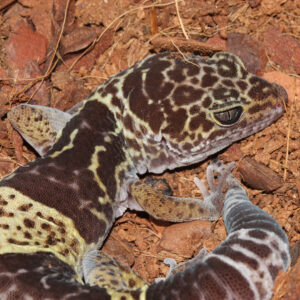Copyright 2021 Evolution Reptiles
All rights reserved.
Copyright 2025 Evolution Reptiles
All rights reserved.
All rights reserved.
The West Indian leopard gecko (Eublepharis fuscus) is a species of leopard gecko found in western India, with it’s range extending to southeastern Pakistan. The term ‘Fuscus’ comes from the meaning ‘dark’ and ‘dusky’. These guys are found in forested hill tracts and scrubland so they like it a little more damp then the common leopard gecko (Eublepharis macularis). They grow to around 25cm in total length.
As a defence mechanism they can detach their tails in order to escape predators, a process called autotomy. The detached tail continues to wriggle and jump for up to 30 minutes – a gruesome spectacle, but one which enables the gecko to make good its escape. In captivity the commonest reasons for tail loss are fighting with cage mates and breeding disagreements. Fortunately this is very unlikely to through handling.
West Indian leopard gecko are classed as crepuscular which means they are most active at dawn and dusk and this is the time they are most likely to come out and hunt for their food. West Indian leopard gecko will use cryptic basking, simply placing a toe, leg or tail out in the sun’s natural UV rays.

If they are provided with a more natural enclosure they will use all of it to their full advantage creating their own burrows and digging away to make themselves at home. They do like to climb and explore so providing ledges and branches to climb over can provide great enrichment for them.
Their diet is broad, although they are insectivores. Anything that moves is fair game, in captivity they are mostly fed on crickets, locusts and Dubias. Waxworms and mealworms are a particular treat, but just like us they can get fixated on food that isn’t terribly good for them long term. Always use a good quality calcium and multivitamin/multimineral supplement.
When it comes to housing a West Indian leopard gecko, we suggest a minimal size of 86.5 x 49 x 50cm (36 x 18 x 18”) when using a wooden vivarium, as wood retains heat well and the extra space is needed to obtain a suitable temperature gradient. If using a glass terrarium, then 60 x 45 x 45cm (24 x 18 x 18”) is absolutely fine – both of these are for single animals.
West Indian Leopard geckos belong to Ferguson zone 1 on the Ferguson scale so should be provided with low levels of UVB exposure. This can be achieved with a range of UVB kits. UVB helps to provide them with natural vitamins such as D3 and calcium which is essential to maintaining a happy healthy gecko.
Temperature in the basking spot should be 32ºC, dropping to 25ºC at the cool end, and at night it should be between 18ºC and 20ºC. Night time heating may need to be provided if you have a particularly cold house.
A water bowl should be offered with fresh water daily, they don’t drink a huge amount and will most likely drink during the night. Cleaning your new pet out is essential to ensure nasty bacterias don’t grow inside the vivarium. We recommend doing a complete clean out every 6-8 weeks providing fresh substrate and giving all of the decor a good scrub down with a reptile safe disinfectant. In the periods between cleanouts regular spot cleans should be carried out to remove any fecal matter.
Copyright 2021 Evolution Reptiles
All rights reserved.